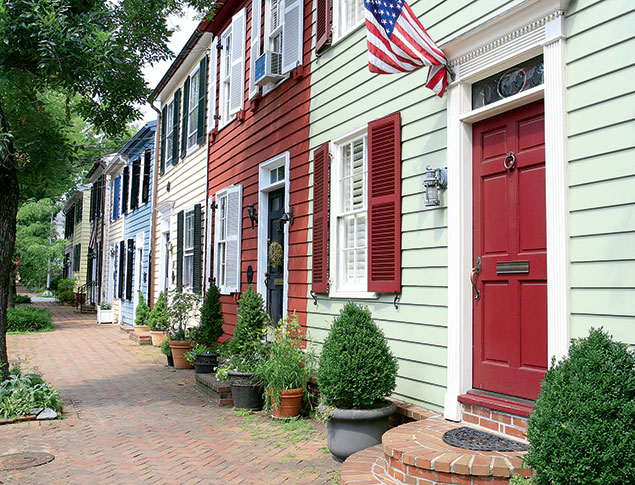1. Sticky Situation
Because Washington is full of old homes, it’s also full of old wooden doors that stick when opened, if they open at all. While there’s nothing you can do about the humidity—a big contributor to jammed doors—there is one easy, often overlooked remedy.
“Ninety-nine percent of the doors I see are not painted on the top or the bottom,” says Steve Crocker, who owns DC Carpentry & Handyman Services. “That’s where the end grain of the wood is. That’s a very absorptive point.”
Sealing the end grain with paint or varnish reduces the amount of moisture taken in by wooden doors, thus diminishing their tendency to swell and get stuck. The top and bottom are the toughest to paint—accessing the bottom of a door requires taking it down from its hinges—but the extra effort can pay off.
2. Busted Bricks
As Washington’s real-estate market booms, in some neighborhoods it seems as if developers are remodeling old homes on every block. Though they’ll likely install beautiful kitchens and hardwood floors, one critical feature they often neglect is the exterior brick.
Edgar Raymundo Jr. and his father run Edgar’s Masonry Construction, which specializes in brick repointing. Raymundo has seen many cases where caulking was used to patch the deteriorating mortar between bricks. Though caulk will temporarily keep water out of the walls—say, long enough to sell a house—it breaks down quickly and can penetrate only about an eighth of an inch of the way between typically four-inch-deep bricks.
Another common trick is using mortar intended for new brick, which is much cheaper than the softer, lime-based mortar appropriate for historic brick. Modern-day mortar costs less than half as much as lime-based, but it’s far too inflexible for old bricks and will cause them to weaken and crumble. If the brick hasn’t been painted, you’ll be able to tell what type of mortar was used. The cheap stuff is gray; the correct mortar is cream or black.
3. Chimney Check
In addition to a cozy atmosphere, fireplaces can bring hazards to a home—even if they’re no longer in use.
“Some folks don’t think they need to worry about their fireplaces since they don’t use them, but they don’t realize that their boilers or water heaters are actually venting into their chimney,” says Chuck Hall, owner of Winston’s Chimney Service in Fairfax and president of the Mid-Atlantic Chimney Association.
Homes built in the 1960s or earlier are often set up this way, with flues connecting boilers, furnaces, and water heaters to the chimney. Hall, who has inspected chimneys at such historic properties as Blair House and the Supreme Court, says a flue deteriorates over time, making it less efficient to heat a space, or worse—potentially allowing gases, including carbon monoxide, to escape into the home. Older flues can be relined with stainless steel to prevent these scenarios.
The bottom line: Even if you aren’t burning wood in the fireplace, you may still need to have your chimney inspected annually.
4. Windowsill Woes
Roland Pratt, owner of Emerald Painting, constantly sees exterior windowsills that haven’t been properly installed. He works primarily on century-plus-old rowhouses in the Capitol Hill area but even sees troublesome sills in new buildings. The problem? They too often tilt inward, toward the home, leading to water damage if the window isn’t well sealed.
“Generally speaking, you need to reinstall the windowsill,” says Pratt. “It’s not that big a deal, but it can make a huge difference. You’re talking about a couple-hundred-dollar repair as opposed to several thousand dollars if you wait until you have rotting baseboards and walls and buckling floors. All because a few drops of water have been getting in over time.”
You can potentially save stress and money by simply checking sills after a heavy rain. Water should run off of them, so any pooling is a red flag.
One thing to keep in mind: In historic districts such as Old Town Alexandria, strict design guidelines dictate what types and dimensions of windows and sills are allowed. Vinyl is a big no-no.
5. Out of Outlets
A hundred years ago, homeowners didn’t have to worry about charging phones, tablets, laptops, and Kindles all at once. As a result, older houses often don’t have enough electrical outlets.
“Thomas Edison thought one outlet in a room was more than you’d ever want,” says Pete Becker, who co-owns Alexandria’s Becker Electric with his brother, Bill. They’ve serviced many historic buildings, including George Washington’s Mount Vernon, the Lyceum, and the Torpedo Factory Art Center.
“Adding outlets correctly, so that you’re marrying new and old wiring correctly, is important,” says Becker. “For safety’s sake, sometimes you need an electrician.”
If you want to give electrical repairs a try yourself (YouTube is full of how-to videos), Becker recommends keeping a log of the work. This way, if you eventually sell your home and an inspector uncovers an electrical problem, you’ll have a record of where else you may have made a similar error.
6. Taking on Water
Washington has both clay soil and frequent downpours, making basements vulnerable to flooding.
“Clay tends to hold water,” says Philip Oldham, a senior inspector at JES in Manassas, which specializes in basement and foundation repair. This means many Washington homes are essentially sitting on top of “a bowl of water with a foundation built in it,” Oldham says. Pre-World War II foundations, typically made of brick, are especially susceptible to water penetration because the mortar breaks down over time.
A compromised foundation isn’t a cheap or easy fix. Among the options offered by waterproofers is installing a drainage system and sump pump in the basement floor or digging down against the outside of the foundation and applying a membrane of tar and silicone to keep moisture out. Depending on the severity of the problem, these jobs can run tens of thousands of dollars.
7. Drip, drip
Almost every faucet installed before the ’70s runs on a rubber washer, says Irvin Schools, owner of H&S Plumbing in Herndon, which also sells hard-to-find plumbing parts. What’s that mean? If you’re woken in the middle of the night by the dripping of your vintage faucet, there’s almost certainly one culprit: a worn-out washer. Schools says some faucets wear out their washers annually, while others last a bit longer. Bill Wagner, owner of W.A. Wagner and Sons Plumbing in Kensington, has clients who call him to replace their washers as often as once every three months.
The good news: Depending on brand, some washers can be picked up at a hardware store. Others are harder to find. You can learn to replace them on your own, but older faucets tend to have more parts and can be trickier to put back together. If you want to keep your home’s original faucets, though, learning how to work with them yourself will save you money.
8. Cracking Up
Plaster walls—found in most homes built before World War II—offer plenty of advantages, such as being harder and more soundproof than drywall. They are, however, prone to cracking in weather like Washington’s.
“Plaster can crack at the slightest shift in the wall, and homes settle, especially in a frost,” says Steve Crocker. “The ground here expands and retracts as it freezes and thaws. It works in a way that causes things to be damaged.”
Patching and painting surface cracks can be a do-it-yourself task, though it’s messy and time-intensive and plaster doesn’t easily disguise mistakes. You’ll have to be meticulous, but like most jobs in older spaces, it’ll be worth it to maintain the beauty and history of your home.

















